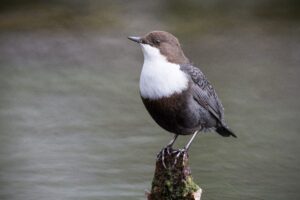Dipper (Cinclus cinclus)
Id: Very distinctive small bird of rushing torrents.
Description
The Dipper is the world’s only truly aquatic song-bird, the only one given to habitual total immersion as a way of life. With few obvious external adaptations to diving – no webbed feet, for example – one might expect it to take a soft option and be somewhat half-aquatic, swimming around in still, gentle water like a toddler at a baby pool. But no, this extraordinary bird likes the fast, highly oxygenated stuff, the water in a hurry. It lives on rivers with strong, challenging currents and white water, where even the ducks are few and far between.

By Dirk-Jan van Roest – https://www.flickr.com/photos/djvanroest/39830455524/, CC BY 2.0, https://commons.wikimedia.org/w/index.php?curid=83682413
The Dipper does have some features to help it in this wild environment. It has very dense plumage, for example, to keep out the icy water, and its feathers are heavily waterproofed with copious oil from its large preen-gland. Its body is streamlined so that the water flows easily past it, and its legs and feet are strong, for gripping rocks under and above the water. The wings, which help to power the bird when it is swimming, have strong muscles. The Dipper also has flaps over its nostrils that close when the bird has submerged and, finally, its eyes are designed to cope with vision in the medium of water.
The Dipper acquires most of its prey from the stream bed, by turning over pebbles with its strong, short bill and fielding what morsels of food dwell beneath them. To do this effectively it uses its wings to “fly” against the current and keep it down at the bottom, and it also grips with its feet, fighting its own buoyancy. Remarkably, a Dipper about to dive doesn’t need to fly up and plunge in, like a portly Kingfisher, using its momentum to immerse. It can simply walk into the water until submerged, barely making a wake. At times it will splash in while flying, or jump in from a rock, too, and it will float on its belly, with wings spread like oars. It revels in the water, and appears to be a master of its environment.
Dippers are, like most river birds, highly territorial. In their turbulent habitat communication can be a problem, and it is thought that this is the reason why Dippers dip. The dipping is a quick flexing of the legs, like a rapid curtsey, and Dippers do it repeatedly, especially in territorial encounters; so it is almost certainly a signal advertising a bird’s presence. Another signal is blinking. Dippers are unusual in having completely feathered eyelids, which happen to be white, and when a bird blinks they are highly conspicuous. Blinking tends to occur alongside the dipping display, and is also probably a signal. Dippers need to moisten their eyes too, of course, but this is done by the transparent third eyelid, the so-called nictitating membrane.
Some individuals keep both breeding and winter territories, which may be the same. They are defended from about September onwards, and may be owned by a pair, or by individuals of either sex. Both sexes sing. The song is adapted to be heard amidst roaring water, as one might expect, and is a strained warble, often with scratchy, harsh and sweet notes all mixed together. Regardless of their territorial bent, Dippers in autumn and may roost in small groups in traditional locations, such as beneath bridges.
Dippers seem almost immune to cold. They sometimes hunt for food under the ice, and can be found in temperatures down to -45°C, although rivers are abandoned if they freeze over completely and the birds may move up to 1000 km to the south, or simply downstream. The breeding season starts very early, with breeding territories maintained or established in January or February. Courtship starts at this time of year, and there may even be construction and refurbishment of nests. Even migratory Dippers in the far north of Europe are back on site by March.
| Habitat | Fast-flowing rivers and streams. |
|---|---|
| Food | Various aquatic insects, acquired by swimming and diving underwater. Mayfly adults and nymphs, caddis fly larvae and stonefly nymphs are important. |
| Movements | Many are resident, but others move downstream in winter. |
| Voice | Usual call is a sharp “zit!”. Song is a warble of strained quality. |
| Pairing style | Monogamous, but occasional bigamy by males. |
| Nesting | Solitary and territorial. |
| Nest | A bulky (often football sized), circular domed structure made out of moss (usually several different species), with an inner cup of grass stems and rootlets, lined with leaves. Usual dimensions: 16-23 cm high, 13-22 cm in width. Hole faces downwards, usually over water. Nest placed on rock ledge by river, also under bridge. Sometimes behind waterfall. |
| Productivity | 2-3 broods a year. |
| Eggs | Usually 4-5. |
| Incubation | 15-18 days, by female alone. |
| Parenting style | Young fed and tended by both parents. |
| Young | Nest-bound, altricial and downy. |
| Food to young | Insects. |
| Leaving nest | Young leave nest at 19-25 days. They can dive and swim immediately, before they can fly. |
